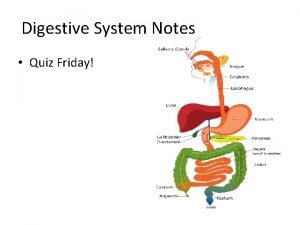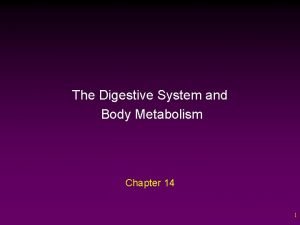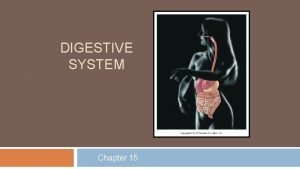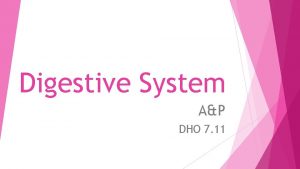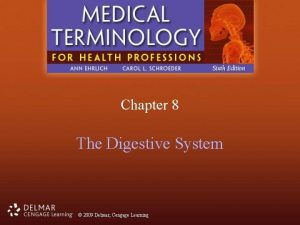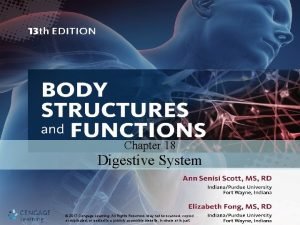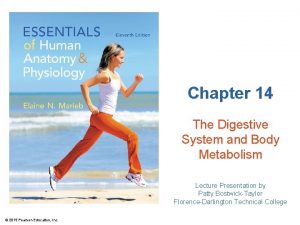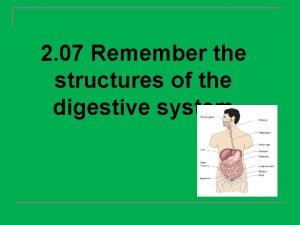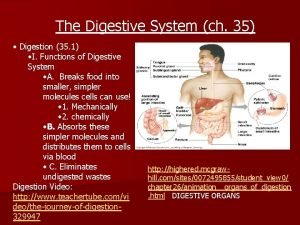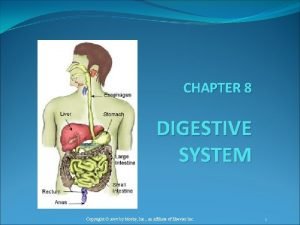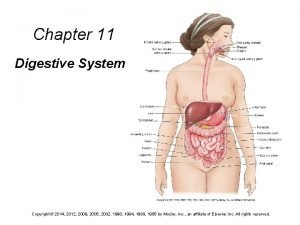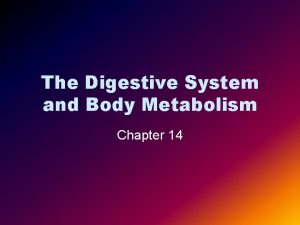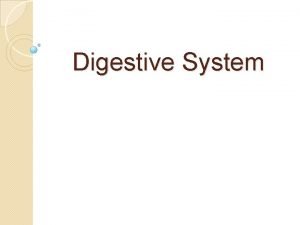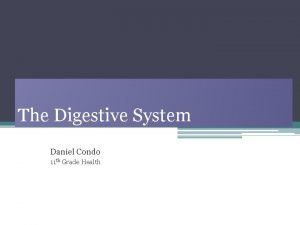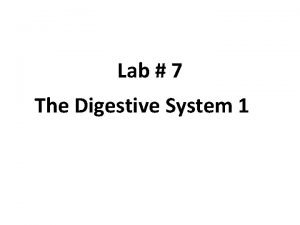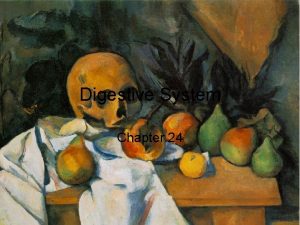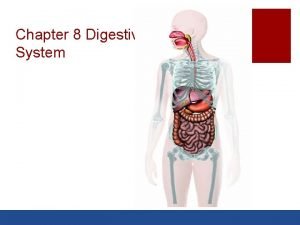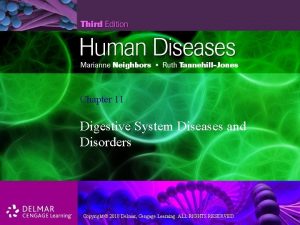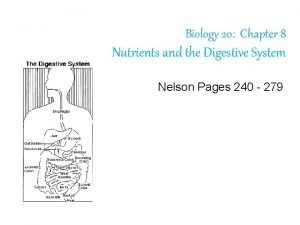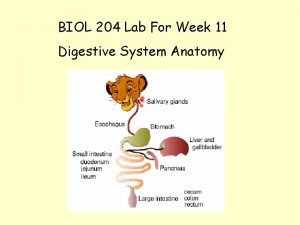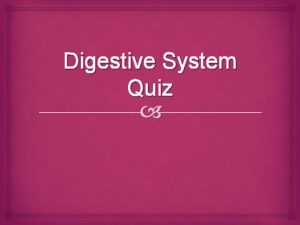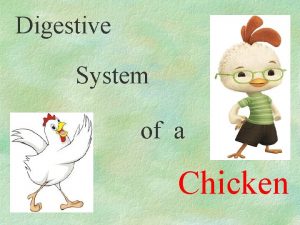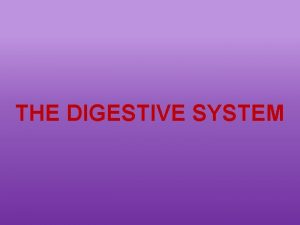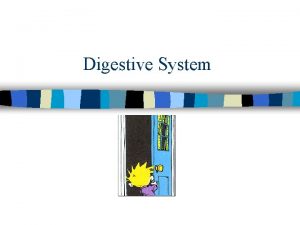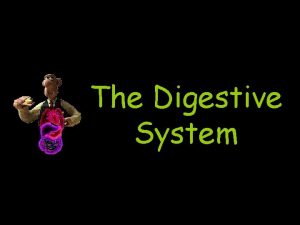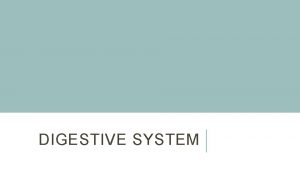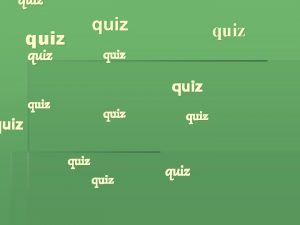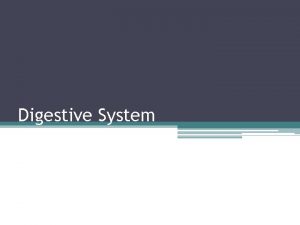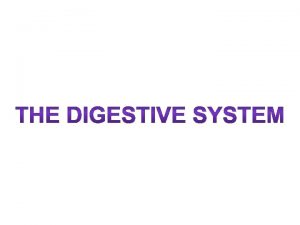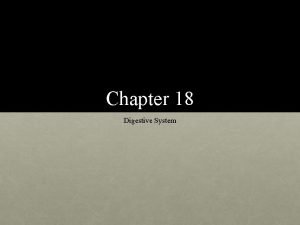The Digestive System Chapter 24 Digestive Quiz 1




























































- Slides: 60

The Digestive System Chapter 24

Digestive Quiz • 1 – 10 questions • Comes straight from power point. Know the function of each section/part of the digestive system and the fluids secreted in each section. • The function of those fluids secreted – EX: Bile is secreted by the ____ and breaks down ____ which is located in the _____.

Overview • • Functions of the Digestive System Anatomy of Digestive System Phases of Digestive Organs – – – – Mouth (Mechanical and Chemical Digestion) Esophagus (Mechanical Digestion) Stomach (Mechanical and Chemical Digestion) Pancreas (Chemical Digestion) Liver and Gallbladder (Chemical Digestion) Small intestine (Mechanical and Chemical Digestion) Large intestine (Mechanical and Chemical Digestion)

The Digestive System • gastrointestinal system • alimentary canal – extends from mouth to anus – mouth, pharynx, esophagus, stomach, small intestine, large intestine (colon) • accessory organs – teeth, tongue, salivary glands, liver, gallbladder, pancreas

The Digestive System • Functions: – – ingestion secretion digestion mixing and propulsion (motility) – absorption – defecation

The Digestive System • Mechanical Digestion – mastication – swallowing – mixing : • increase the contact of food and digestive chemicals – peristalsis: • intermittent contraction of muscles within the GI tract facilitate the movement of food

The Digestive System • Chemical digestion – water is used to break chemical bonds (hydrolysis) – Fats are broken down into fatty acids and glycerol – Carbohydrates are broken down from complex polysaccharides into monosaccharides – proteins are broken down into polypeptides and amino acids

The Digestive System • Responsible for facilitating the body’s metabolic processes – Catabolism: larger molecules are broken into smaller molecules (digestion) – Anabolism: smaller molecules are used as building blocks for larger molecules (liver)

Digestive System Anatomy • the walls of the GI tract have the same 4 -layered arrangement of tissues – – mucosa submucosa muscularis serosa

“Brain of the Gut” ENTERIC NERVOUS SYSTEM To ANS and CNS neurons Myenteric plexus: regulates motility Extrinsic influence Autonomic NS: - Parasympathetic stimulates ENS - Sympathetic inhibits ENS Interneuron GI reflex pathways Submucosal plexus: controls secretions Motor neuron Regulate secretions and motility based on contents of the lumen Sensory neuron chemoreceptors stretch receptors Longitudinal and circular smooth muscle layers of the muscularis Mucosal epithelium Mechanical Digestion Chemical Digestion

Digestion • 3 phases – cephalic phase – gastric phase – intestinal phase

Digestion – Cephalic Phase • smell, sight, thought, initial taste of food • activates the cerebral cortex, hypothalamus and brain stem to prepare for digestion – facial and glossopharyngeal nerves stimulation saliva secretion – vagus nerves stimulate gastric juice secretion

Digestion – Gastric Phase • this phase begins once food reaches the stomach – secretion of gastric juice – increased gastric motility • Neural regulation – stretch and chemoreceptors • Hormonal regulation – gastrin – secreted in from cells in the stomach

Digestion – Intestinal Phase • Begins once food enters the small intestine and promotes the continued digestion of foods • neural regulation – distension of the intestine • hormonal regulation – stimulates further breakdown of proteins and fatty acids

The Mouth • Oral/buccal cavity • mechanical digestion: – mastication breaks the food down • mixes food with saliva • formation of a soft bolus

The Mouth • chemical digestion: – saliva starts the digestive process – 99. 5% water, dissolved ions, bacteriolytic lysosomes • Digestive enzymes: – salivary amylase: begins the breakdown of starch • polysaccharides broken down into mono, di, and tri-saccharides • salivary amylase is inactivated by stomach acids – lingual lipase: begins the breakdown of fats – not active until the stomach reaches a specific acidity level – triglycerides broken down into diglycerides)

The Mouth • Salivary regulation is under the control of the autonomic nervous system – parasympathetic stimulation • promotes secretion of saliva – sympathetic stimulation • decreases salivation • touch, smell, taste, and psychological factors increase

The Esophagus • upper esophageal sphincter – skeletal muscle – regulates movement from mouth to esophagus – voluntary • lower esophageal sphincter – smooth muscle – regulates movement from esophagus into stomach – involuntary

Deglutition (swallowing) Nasopharynx Hard palate Soft palate Uvula Oropharynx Bolus Tongue Epiglottis Laryngopharynx Larynx Esophagus (a) Position of structures before swallowing (b) During pharyngeal stage of swallowing

Deglutition • Esophageal phase • peristalsis: coordinated contractions of the circular and longitudinal muscularis layer pushes the bolus onward

The Esophagus • GERD: gastroesophageal reflux disease – failure of the LES to close adequately after swallowing – food can move from the stomach back into the lower portion of the esophagus • Heart Burn – HCl from the stomach can irritate the esophageal wall • Alcohol and smoking relax the LES • foods that strongly stimulate HCl secretion – coffee, chocolate, tomatoes, fatty foods, OJ, onions

The Stomach Note the oblique layer of smooth muscle in the gastric muscularis (limited to the body of the stomach) Function Holds and mixes food until it can pass into the small intestine

Mechanical Digestion in the Stomach • Gentle, rippling, peristaltic movements called mixing waves pass over the stomach every 15 to 25 seconds once food enters the stomach. – These waves macerate food, mix it with secretions of the gastric glands, and reduce it to a soupy liquid called chyme. • the mixing waves get stronger further down the stomach

Mechanical Digestion in the Stomach • as a mixing wave reaches the pylorus ~3 m. L of chyme enters the duodenum = gastric emptying • the chyme enters the duodenum to begin the intestinal phase of digestion

The Stomach • The strongly acidic nature of gastric juice kills microbes, partially denatures proteins in food, and converts pepsinogen into pepsin – Pepsin is the only proteolytic enzyme in the stomach – Gastric lipase splits triglycerides – What other lipase is active in the stomach? – Intrinsic factor (IF) is needed for absorption of vitamin B 12 (essetial for RBC production, brain and nervous system health).

The Stomach • Disruption of the balance b/w HCl production, pepsin secretion, and mucosal defenses may erode the stomach's epithelial lining – excessive alcohol consumption, or use of NSAIDS like aspirin or ibuprofen may exacerbate this condition

Peptic Ulcer Disease • ulcers that develop in areas of the GI tract exposed to gastric juice • CAUSES: – helicobacter pylori (most common) • produce an enzyme that shields the bacterium from gastric juice, but damages the protective mucous layer • NSAIDS (aspirin, ibuprofen) – hypersecretion of HCl • TREATMENT: • Tums, Maalox • Proton pump inhibitors (if HCl hypersecretion is the issue)

Vomiting: emesis • STIMULUS – irritation and distension of the stomach (strongest stimulus) – unpleasant sights, general anesthesia, dizziness, drugs • Control – sensory nerve afferent impulses to the vomiting center in the medulla oblongata – motor efferents activate contraction of the GI organs, diaphragm and abdominal muscles • The stomach is squeezed between the diaphragm and abdominal muscles • Prolonged vomiting alkalosis due to the loss of gastric juice

The Stomach • epithelial cells of the stomach are impermeable to most materials, and very little absorption takes place – mucous cells absorb water, ions, short chain FA’s, some drugs (aspirin), and alcohol • Within 2 to 4 hours after eating a meal, the stomach has emptied its contents into the duodenum – Foods rich in carbohydrate spend the least time – High-protein foods remain somewhat longer – Emptying is slowest after a fat-laden meal containing large amounts of triglycerides

Gastric Bypass Gastric Sleeve

Gastric Band

Anatomy of the lower GI tract

The Pancreas • The pancreas secretes enzymes that digest food in the small intestine, and bicarbonate which buffers the acidic chyme leaving the stomach • Pancreatic juice secreted into the pancreatic duct which takes it to the small intestine Duodenum SUPERIOR Common bile duct Body of pancreas Major duodenal papilla Pancreatic duct Head of pancreas MEDIAL Tail of pancreas (e) Anterior view LATERAL

Pancreatitis • inflammation of the pancreas • CAUSES: alcohol abuse, chronic gallstones, cystic fibrosis, hypercalcemia, hyperlipidemia • excessive trypsin secretion results in the digestion of the pancreatic cells

Pancreatic Cancer • usually affects people over the age of 50, more common in males • Few symptoms until the cancer is in an advanced stage • High mortality rate • 4 th most common cause of death from cancer • Research suggests it is linked to high fatty food diet, high alcohol consumption, genetics, smoking, and chronic pancreatitis

Liver and Gallbladder • The liver is the body’s largest gland second largest organ • The liver is made up of lobules that house – hepatocytes – bile canaliculi – hepatic sinusoids

The Liver and Gallbladder • Hepatocytes are the major functional cells of the liver • hepatocytes secrete bile into the bile canaliculi • bile = an excretory product that helps emulsify fats for the watery environment of small intestine digestive juices. Hepatic sinusoids Bile canaliculi

The Liver and Gallbladder • Bile: an alkaline solution – consists of water, bile salts, cholesterol, and bile pigments • Bile salts are used in the small intestine for the emulsification and absorption of lipids • Without bile salts, most of the lipids in food would be passed out in feces, undigested. • The dark pigment in bile is called bilirubin and comes from the catabolism of old red blood cells.

The Liver and Gallbladder • Surgical removal of the gall bladder (cholecystectomy) results in severe indigestion if the person eats a large meal high in fat content.

Hepatocyte Functions Non-metabolic Functions • Phagocytosis of old or worn-out cells (in sinusoids)and secretes them into bile (bilirubin = heme in RBC’s) • Detoxification of certain drugs and alcohol • Modifies vitamin D to its active form • Storage for glycogen, vitamins and minerals

Gallstones • insufficient bile salts or excessive cholesterol content of bile may cause cholesterol to crystallize and form gallstones • may obstruct the bile flow into the duodenum • TREATMENT: dissolving drugs, shock-wave therapy, surgery – cholecystectomy may be an option for recurring gallstones

Jaundice • CAUSE: buildup of bilirubin • SIGNS: yellowish coloration of the eyes, skin, and mucous membranes • CATEGORIES – prehepatic jaundice: excessive bilirubin production – hepatic jaundice: liver disease – extrahepatic jaundice: blockage of bile drainage

The Small Intestine • The small intestine is divided into 3 regions: – The duodenum (10 in) – The jejunum (8 ft) – The ileum (12 ft) • In the small intestine, digestion continues, while the process of absorption begins

Mechanical Digestion Small Intestine • Regulated by the myenteric plexus • Segmentations: localized mixing contractions where the intestine is distended – used to mix chyme and bring it into contact with the mucosa for absorption

The Small Intestine • circular folds in the mucosa and submucosa encourage the turbulent flow of chyme

Mechanical Digestion in the Small Intestine • Migrating motility complexes – peristalsis – begins once absorption is complete and the intestine is less distended – begins in lower stomach and pushes chyme forward – takes 90 -120 min to move from stomach to ileum, then another begins – food stays in SI for 3 -5 hrs

Histology of the small intestine Circular folds (plicae circulares) • circular folds: folds in the mucosa and submucosa layer • Villi: multicellular fingerlike projections within the mucosa • microvilli: fingerlike projections on the apical surface of the absorptive cells (brush border) Circular folds Villi Submucosa muscularis Serosa

Histology of the Small Intestine • the mucosa contains intestinal glands that secrete intestinal juice (water, mucous, and HCO 3 -) • intestinal juice along with pancreatic juice facilitate the chemical digestive process in the lumen of the small intestine • brush-border enzymes complete chemical digestion

Chemical Digestion of Small Intestine Brush Border Enzymes • Carbohydrate digestion - enzymes located on the brush border of the absorptive cells – – α dextrinase: clips glucose molecules off α-dextrins maltase: breaks maltose into 2 glucose molecules sucrase: breaks sucrose into glucose and fructose lactase: breaks lactose into glucose and galactose • The small intestine only absorbs monosaccharides

Lactose Intolerance • absorptive cells fail to produce enough lactase • Undigested lactose in chyme causes excess of fluid retention in feces • Bacteria ferment the undigested lactase in the colon producing gas • Symptoms: diarrhea, gas, bloating, abdominal cramps <a href="http: //www. flickr. com/photos 17129502@N 00/3507124575/">: : sämyii: : </a> via <a href="http: //compfight. com">Compfight</a> <a href="http: //www. flickr. com/help/general/#147">cc</a>

Chemical Digestion of Small Intestine • Protein digestion – Stomach – pepsin (from pepsinogen) – Pancreatic juice peptidases • trypsin, chymotripsin, carboxypeptidase, elastase – small intestine brush border enzymes • aminopeptidase – cleaves amino acids off a peptide • dipeptidase – splits dipeptides into single amino acids

Chemical Digestion of Small Intestine • Lipid digestion – In the stomach: lingual lipase, gastric lipase – In the small intestine: pancreatic lipase • TGs broken into FA’s and monoglycerides • Emulsification: bile salts break the larger lipid globules into small lipid globules – Pancreatic lipase acts on the small globules

Intestinal Absorption • The passage of digested nutrients into the blood or lymph • 90% of absorption occurs in the small intestine • Methods of absorption – diffusion, facilitated diffusion, osmosis, active transport

Intestinal Absorption INGESTED AND SECRETED ABSORBED Saliva (1 liter) • Water – ALL water absorption occurs via osmosis from the intestinal lumen to the capillaries Ingestion of liquids (2. 3 liters) Gastric juice (2 liters) Bile (1 liter) Pancreatic juice (2 liters) Intestinal juice (1 liter) Small intestine (8. 3 liters) Total ingested and secreted = 9. 3 liters Large intestine (0. 9 liters) Excreted in feces (0. 1 liter) Total absorbed = 9. 2 liters Fluid balance in GI tract

Alcohol absorption • lipid-soluble simple diffusion • absorption is most rapid in the small intestine • the longer alcohol remains in the stomach the slower blood alcohol levels will rise • alcohol dehydrogenase in the gastric mucosa detoxifies alcohol • females and asian males have low rates of activity of alcohol dehydrogenase

The Large Intestine • The large intestine is about 5 feet in length • Starting at the ileocecal valve, the large intestine has 4 parts: – The cecum – The colon • • ascending transverse descending sigmoid – The rectum – The anal canal

Mechanical Digestion in the large intestine • Immediately after a meal the gastroileal reflex intensifies peristalsis in the ileum and forces any chyme there into the cecum • Haustral churning – the haustra of the colon distend as chyme enters – a specific degree of distension triggers contraction and the chyme is squeezed into the next haustra • Mass peristalsis – a strong Gastric distension initiates mass peristalsis by the ANS

The Large Intestine • ~9 liters of fluid enter the small intestine daily – The small intestine absorbs about 8 liters – the remainder passes into the large intestine, where most of the rest of it is also absorbed • Only 100 m. L/d of water is

Chemical Digestion in the large intestine • No digestive enzymes are secreted • However, bacteria (flora) in the intestine ferment any remaining carbohydrates – byproducts = hydrogen, carbon dioxide, methane • Contribute to flatulence

The Large Intestine • Though the human body consists of about 100 trillion cells, we carry about ten times as many microorganisms in the intestines. Bacteria make up most of the flora in the colon and about 60% of the dry mass of feces. • As these bacteria digest/ferment left-over food, they secrete beneficial chemicals such as vitamin K, biotin (a B vitamin), and some
 Digestive system respiratory system and circulatory system
Digestive system respiratory system and circulatory system Ingestion and digestion
Ingestion and digestion 4 functions of the digestive system
4 functions of the digestive system Nervous system and digestive system
Nervous system and digestive system Figure 14-1 digestive system
Figure 14-1 digestive system Chapter 15 digestive system
Chapter 15 digestive system Chapter 7 11 digestive system
Chapter 7 11 digestive system Chapter 8 the digestive system
Chapter 8 the digestive system Study guide chapter 35 section 1 the digestive system
Study guide chapter 35 section 1 the digestive system Chapter 18 digestive system
Chapter 18 digestive system Figure 14-1 is a frontal view of the digestive system
Figure 14-1 is a frontal view of the digestive system Chapter 7:11 digestive system labeling
Chapter 7:11 digestive system labeling Chapter 35 section 1 the digestive system answer key
Chapter 35 section 1 the digestive system answer key Chapter 8 the digestive system
Chapter 8 the digestive system Anatomy and physiology coloring workbook figure 14-1
Anatomy and physiology coloring workbook figure 14-1 Chapter 7:11 digestive system
Chapter 7:11 digestive system The digestive system and body metabolism
The digestive system and body metabolism Study the digestive maze below
Study the digestive maze below Chapter 7:11 digestive system
Chapter 7:11 digestive system On digestion
On digestion Lamina propria
Lamina propria Big mac matrix
Big mac matrix Pyloric valve
Pyloric valve Pharynge
Pharynge Chapter 7 11 digestive system
Chapter 7 11 digestive system Chapter 8 the digestive system
Chapter 8 the digestive system Chapter 7:11 digestive system
Chapter 7:11 digestive system Hát kết hợp bộ gõ cơ thể
Hát kết hợp bộ gõ cơ thể Slidetodoc
Slidetodoc Bổ thể
Bổ thể Tỉ lệ cơ thể trẻ em
Tỉ lệ cơ thể trẻ em Voi kéo gỗ như thế nào
Voi kéo gỗ như thế nào Tư thế worms-breton
Tư thế worms-breton Hát lên người ơi
Hát lên người ơi Môn thể thao bắt đầu bằng từ đua
Môn thể thao bắt đầu bằng từ đua Thế nào là hệ số cao nhất
Thế nào là hệ số cao nhất Các châu lục và đại dương trên thế giới
Các châu lục và đại dương trên thế giới Công thức tiính động năng
Công thức tiính động năng Trời xanh đây là của chúng ta thể thơ
Trời xanh đây là của chúng ta thể thơ Mật thư anh em như thể tay chân
Mật thư anh em như thể tay chân 101012 bằng
101012 bằng độ dài liên kết
độ dài liên kết Các châu lục và đại dương trên thế giới
Các châu lục và đại dương trên thế giới Thể thơ truyền thống
Thể thơ truyền thống Quá trình desamine hóa có thể tạo ra
Quá trình desamine hóa có thể tạo ra Một số thể thơ truyền thống
Một số thể thơ truyền thống Bàn tay mà dây bẩn
Bàn tay mà dây bẩn Vẽ hình chiếu vuông góc của vật thể sau
Vẽ hình chiếu vuông góc của vật thể sau Biện pháp chống mỏi cơ
Biện pháp chống mỏi cơ đặc điểm cơ thể của người tối cổ
đặc điểm cơ thể của người tối cổ Thế nào là giọng cùng tên
Thế nào là giọng cùng tên Vẽ hình chiếu đứng bằng cạnh của vật thể
Vẽ hình chiếu đứng bằng cạnh của vật thể Tia chieu sa te
Tia chieu sa te Thẻ vin
Thẻ vin đại từ thay thế
đại từ thay thế điện thế nghỉ
điện thế nghỉ Tư thế ngồi viết
Tư thế ngồi viết Diễn thế sinh thái là
Diễn thế sinh thái là Dạng đột biến một nhiễm là
Dạng đột biến một nhiễm là Bảng số nguyên tố lớn hơn 1000
Bảng số nguyên tố lớn hơn 1000 Tư thế ngồi viết
Tư thế ngồi viết


